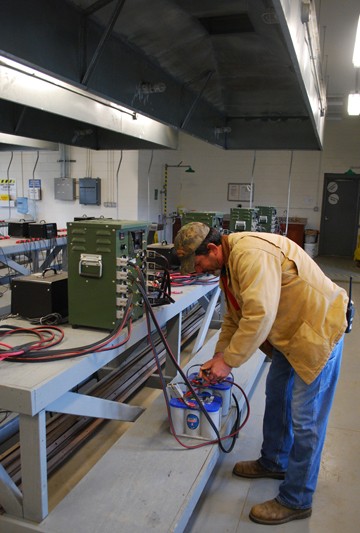
FORT POLK, La. -- North of Fort Polk in the piney woods of Peason Ridge is the Digital Multi-Purpose Battle Action Complex, a 240-acre tract of land replete with cameras for recording military exercises and delivering after action reviews. The DMPBAC is one-of-a-kind as far as battle simulation. Every mobile target is battery operated and everything is remote-controlled at the site.
The facility deals with aerosol, paints, petroleum oils and lubricants. Despite a number of possibly hazardous materials on hand at the operations center, DMPBAC and Siegfried Milerski, an electronics technician at the site, earned recognition for full environmental compliance from Fort Polk's Environment and Natural Resources Management Division Feb. 19. Since Milerski joined Oak Grove, the subcontractor to Raytheon that runs DMPBAC, three years ago, DMPBAC has seen no reportable environmental accidents.
In addition to his normal duties changing out batteries on targets and resetting sites throughout the forested complex, Milerski serves as the environmental compliance officer for DMPBAC.
"It's basically an extra duty within my job," said Milerski. "When I first came here there wasn't an environmental program, so I had to manage the requirements for us to be in compliance. I just took it from there. When inspection time came around, they noticed that we're doing some good things. They're basic, fundamental things, but we were doing them and we didn't have any deficiencies."
The job includes maintaining environmental files correctly for easy reference during inspections by the ENRMD, proper storage of potentially hazardous materials and keeping the crew ready for any environmental spills by keeping a spill kit ready and performing regular practice spills, using water to simulate more harmful chemicals.
Every harmful liquid requires primary and secondary containment. In case primary containment fails, secondary containment ensures that the spill will not affect the ground around it. Though DMPBAC performs little automotive maintenance, used oil and bad diesel are stored in drums sitting atop a grid above a tub. If the drums leak, the tubs catch the overflow. Beside the drums are a set of lockers with environmentally harmful liquids, partially used environmentally harmful liquids, flammable liquids and partially used flammable liquids. Each of these lockers has a lip at the bottom in case one of the containers leaks. The DMPBAC team even took the initiative to construct a wooden platform for the lockers to sit on to prevent them from resting unevenly on the ground.
DMPBAC's battery recharge facility, where the car batteries that run the moving targets are recharged, is also rigorously maintained to prevent environmental contamination. The potential harm to workers and the environment necessitates certain controls.
"The batteries put off a gas when they're heated," said Milerski. "It's not much, but when you have four hundred batteries charging, it can put off some. When you're putting the clamps on and taking them off, the lead shavings fall off, and you have small particles that can get in the dust and mud and when you mix all that up it gets in the air."
To combat harmful gas and lead particles in the air, large vents sit above the battery charging tables. For the lead shavings that reach the ground, grates have been placed in the floor between every table. Every day the floor is wet mopped so that the poisonous dust will drain out into a large tank sitting inside a trash roller. When collected there in large supply, the DMPBAC team tests the water's pH balance. When the water has a neutral pH, it is poured into a nearby retention pond. If the water were either acidic or basic (and it has yet to be either during Milerski's tenure), then they would call ENRMD to handle the situation.
Milerski's supervisor, Jeff Lindley, recognized his experience and found him to be an excellent fit for the additional duties.
"He worked at the Fort Polk environmental office before he came here, so he was the man for the job, a subject matter expert," said Lindley. "He's taken it and ran with it."
"I worked for ENRMD for four years and then I went to Iraq and worked for a contractor there as an environmental coordinator," said Milerski. "When I got back, I came out here to the DMPBAC, and I felt I could make the environmental program more efficient because I already knew about the regulations and the requirements. It was second nature to me."
Milerski does not credit himself solely for the success of the environmental program at the DMPBAC. He also credits those who work with him on the environmental program and Fort Polk's environmental offices.
"Everyone does their part," said Milerski. "They took a stab at creating a wooden platform for our hazmat lockers so they wouldn't be in the mud or dirt. They built an aerosol can storage for us - a wooden box - so we can consolidate our empty aerosol cans."
Milerski also thanks those who give him the test.
"Thomas Euchort, the environmental compliance service technician, the one who comes out and does the quarterly inspection - if I need any assistance from him, if I have a question, I can get a hold of him and he'll inform me of what I need to do if I have a problem with something," said Milerski.
Lindley is happy with Milerski, who has gone beyond the duties of his job.
"We've never really had an incident," said Lindley. "We deal with a lot of hazardous materials with all the batteries and fuel, and to my knowledge everything's been A-OK. He's on top of it."

Social Sharing